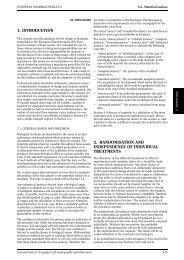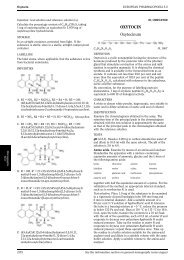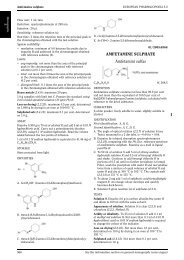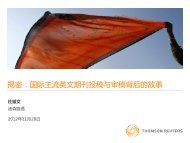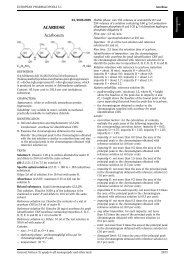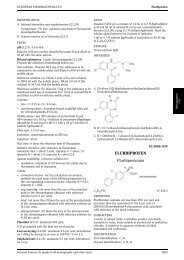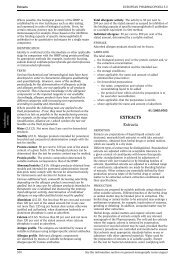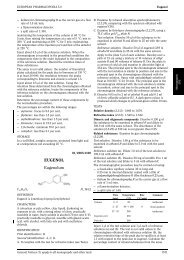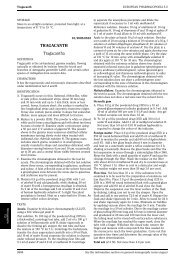Amobarbital sodium.pdf
Amobarbital sodium.pdf
Amobarbital sodium.pdf
Create successful ePaper yourself
Turn your PDF publications into a flip-book with our unique Google optimized e-Paper software.
Amoxicillin <strong>sodium</strong> EUROPEAN PHARMACOPOEIA 5.0<br />
Reference solution. Dilute 0.5 ml of the test solution to<br />
100 ml with alcohol R.<br />
Apply separately to the plate 20 µl of each solution. Develop<br />
over a path of 15 cm using the lower layer of a mixture<br />
of 5 volumes of concentrated ammonia R, 15volumes<br />
of alcohol R and 80 volumes of chloroform R. Examine<br />
the plate immediately in ultravioletlightat254nm.Spray<br />
with diphenylcarbazone mercuric reagent R. Allowthe<br />
plate to dry in air and spray with freshly prepared alcoholic<br />
potassium hydroxide solution R diluted 1 in 5 with<br />
aldehyde-free alcohol R. Heatat100°Cto105°Cfor5min<br />
and examine immediately. When examined in ultraviolet<br />
light and after spraying, any spot in the chromatogram<br />
obtained with the test solution, apart from the principal<br />
spot, is not more intense than the spot in the chromatogram<br />
obtained with the reference solution (0.5 per cent). Disregard<br />
any spot at the starting-point.<br />
Loss on drying (2.2.32). Not more than 3.0 per cent,<br />
determinedon0.50gbydryinginanovenat130°C.<br />
ASSAY<br />
Dissolve 0.200 g in 5 ml of ethanol R. Add0.5mlof<br />
thymolphthalein solution R and 10 ml of silver nitrate<br />
solution in pyridine R. Titratewith0.1 M ethanolic <strong>sodium</strong><br />
hydroxide until a pure blue colour is obtained. Carry out<br />
a blank titration.<br />
1mlof0.1 M ethanolic <strong>sodium</strong> hydroxide is equivalent to<br />
24.83 mg of C 11<br />
H 17<br />
N 2<br />
NaO 3<br />
.<br />
STORAGE<br />
Storeinanairtightcontainer.<br />
AMOXICILLIN SODIUM<br />
Amoxicillinum natricum<br />
01/2005:0577<br />
corrected<br />
C 16<br />
H 18<br />
N 3<br />
NaO 5<br />
S M r<br />
387.4<br />
DEFINITION<br />
Amoxicillin <strong>sodium</strong> contains not less than 89.0 per<br />
cent and not more than the equivalent of 102.0 per<br />
cent of <strong>sodium</strong> (2S,5R,6R)-6-[[(2R)-2-amino-2-(4-<br />
hydroxyphenyl)acetyl]amino]-3,3-dimethyl-7-oxo-4-thia-1-<br />
azabicyclo[3.2.0]heptane-2-carboxylate, calculated with<br />
reference to the anhydrous substance.<br />
CHARACTERS<br />
A white or almost white powder, very hygroscopic, very<br />
soluble in water, sparingly soluble in ethanol, very slightly<br />
soluble in acetone.<br />
IDENTIFICATION<br />
First identification: A, D.<br />
Second identification: B, C, D.<br />
A. Dissolve 0.250 g in 5 ml of water R, add0.5mlofdilute<br />
acetic acid R, swirlandallowtostandfor10mininiced<br />
water. Filter the crystals and wash with 2 ml to 3 ml<br />
of a mixture of 1 volume of water R and 9 volumes of<br />
acetone R, then dry in an oven at 60 °C for 30 min.<br />
Examine by infrared absorption spectrophotometry<br />
(2.2.24), comparing with the spectrum obtained with<br />
amoxicillin trihydrate CRS.<br />
B.Examinebythin-layerchromatography(2.2.27), using a<br />
TLC silanised silica gel plate R.<br />
Test solution. Dissolve25mgofthesubstancetobe<br />
examined in 10 ml of <strong>sodium</strong> hydrogen carbonate<br />
solution R.<br />
Reference solution (a). Dissolve25mgofamoxicillin<br />
trihydrate CRS in 10 ml of <strong>sodium</strong> hydrogen carbonate<br />
solution R.<br />
Reference solution (b). Dissolve25mgofamoxicillin<br />
trihydrate CRS and 25 mg of ampicillin trihydrate CRS<br />
in 10 ml of <strong>sodium</strong> hydrogen carbonate solution R.<br />
Apply to the plate 1 µl of each solution. Develop over a<br />
path of 15 cm using a mixture of 10 volumes of acetone R<br />
and 90 volumes of a 154 g/l solution of ammonium<br />
acetate R, the pH of which has been adjusted to 5.0 with<br />
glacial acetic acid R. Allow the plate to dry in air and<br />
expose it to iodine vapour until the spots appear. Examine<br />
in daylight. The principal spot in the chromatogram<br />
obtained with the test solution is similar in position,<br />
colour and size to the principal spot in the chromatogram<br />
obtained with reference solution (a). The test is not<br />
valid unless the chromatogram obtained with reference<br />
solution (b) shows 2 clearly separated spots.<br />
C. Place about 2 mg in a test-tube about 150 mm long and<br />
15 mm in diameter. Moisten with 0.05 ml of water R and<br />
add 2 ml of sulphuric acid-formaldehyde reagent R.<br />
Mix the contents of the tube by swirling; the solution is<br />
practically colourless. Place the test-tube in a water-bath<br />
for 1 min; a dark yellow colour develops.<br />
D. It gives reaction (a) of <strong>sodium</strong> (2.3.1).<br />
TESTS<br />
Appearance of solution. Dissolve1.0ginwater R and<br />
dilute to 10.0 ml with the same solvent. Immediately after<br />
dissolution, the solution is not more opalescent than<br />
reference suspension II (2.2.1). The solution may show an<br />
initial, but transient, pink colour. After 5 min, the absorbance<br />
measured at 430 nm (2.2.25) is not greater than 0.20.<br />
pH (2.2.3). Dissolve 2.0 g in carbon dioxide-free water R<br />
and dilute to 20 ml with the same solvent. The pH of the<br />
solution is 8.0 to 10.0.<br />
Specific optical rotation (2.2.7).Dissolve62.5mgina4g/l<br />
solution of potassium hydrogen phthalate R and dilute to<br />
25.0 ml with the same solution. The specific optical rotation<br />
is+240to+290,calculatedwithreferencetotheanhydrous<br />
substance.<br />
Related substances. Examinebyliquidchromatography<br />
(2.2.29) as described under Assay. Inject 50 µl of reference<br />
solution (d) and elute isocratically until elution of the<br />
amoxicillin peak. Inject 50 µl of test solution (b) and start<br />
the elution isocratically. Immediately after elution of the<br />
amoxicillin peak start the following linear gradient. If the<br />
mobile phase composition has been adjusted to achieve the<br />
required resolution, the adjusted composition will apply at<br />
time zero in the gradient.<br />
Time<br />
(min)<br />
Mobile phase A<br />
(per cent V/V)<br />
Mobile phase B<br />
(per cent V/V)<br />
Comment<br />
0-25 92 → 0 8 → 100 linear gradient<br />
25 - 40 0 100 isocratic<br />
40 - 55 92 8 re-equilibration<br />
990 See the information section on general monographs (cover pages)



